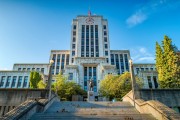British Columbia is committed to meeting its net-zero emissions targets, but there are still questions about how they will reach that goal — one of the biggest being how are FortisBC and Pacific Northern Gas, the province’s two natural gas utilities, planning to meet the proposed cap on their systems' emissions?
The gas distribution system has a role to play in a net-zero B.C., but it will need to look substantially different than it does today. If B.C. is going to meet its targets, we must electrify buildings and focus on using existing gas distribution systems to relieve the stress on electrical systems when they are stretched to capacity during the coldest days of the year.
The province’s CleanBC Roadmap 2030 introduces a number of new measures across all sectors. It includes increased carbon pricing, a push for industry to eliminate methane emissions, and a focus on additional infrastructure for electric vehicles. The roadmap also announces a greenhouse gas (GHG) emissions cap for gas utilities that will require FortisBC-gas, B.C.’s largest gas utility, to reduce emissions from their customers by about half. This will also be the case for Pacific Northern Gas, the smaller gas utility that serves the north of the province.
While these utilities anticipate being able to lower their customers’ emissions by delivering low-carbon gaseous fuels, including biomethane and some forms of hydrogen, instead of fossil gas, their capacity to do so at scale is uncertain because there is a limited supply of these low-carbon gases.
It’s still uncertain how much supply can be produced in B.C. or how much will be available for import from the United States. The amount of that supply that will be available to decarbonize buildings will depend on competition from other sectors of the economy that will also seek these resources to meet their climate targets. Anyone using these fuels will also need to measure and track the carbon content, as not all renewable fuels are equally green.
This all puts a big spotlight on FortisBC. In our paper, Regulating Gas in B.C. to Achieve 2030 and 2050 Climate Goals, we argue that complying with the emissions cap will require the company to support the electrification of buildings and shift its gas distribution infrastructure to more of a supporting role when it comes to heating buildings—including homes, schools and businesses—which contributed to 10 per cent of B.C.’s total emissions in 2020.
Up to now, the utility advanced a climate plan focused on ‘drop-in fuels’, which means keeping its basic business model the same, and shifting the share of total fuel distributed to homes and businesses from fossil gas to renewable gas over time. While this option seems straightforward, it is not ideal. It would require a significant portion of renewable gas to be sourced from outside B.C. and direct a lion’s share of renewable gas supply to a sector that could be decarbonized through electrification. This approach could increase competition with other sectors for what could be a very limited and expensive source of energy. It could also allow gas utilities to continue distributing fossil gas beyond 2030 and 2050.
There is another option: FortisBC could invest in deep energy retrofits and the local production of renewable gases. Its gas delivery system could be used to provide peak heating resources, instead of base-load heating. In this model, most buildings would be heated using clean electricity, except in the coldest days of the year, when gas backup would be used to relieve the stress on the electrical systems when it is stretched to capacity. A recent memorandum of understanding between Énergir and Hydro Québec, the Province of Québec’s gas and electricity utilities, offers a useful template for such a partnership.
This business model for gas delivery has not been explored openly by B.C. gas utilities. FortisBC is, however, developing various programs that are aligned with such a model, including launching a pilot program for deep retrofitting single-family homes and multi-unit residential buildings, another for hybrid systems, and investing in developing the renewable gas supply in B.C.
Moving forward, FortisBC must present an integrated vision of how these programs could be delivered at scale and combined with electrification to deliver a sustainable net-zero energy system. As an important B.C.-based company and employer, it would ensure the company continues to be to be an economic driver for the province.
Regardless of the path taken, the bottom line is clear: For B.C. to reach its net-zero goals, FortisBC and Pacific Northern Gas will need to present renewed visions for their business models.
The onus to do this work isn’t all on them. The province must provide a clearer direction for utilities by putting a regulatory framework in place quickly and facilitating joint planning between gas and electric utilities for different net-zero future scenarios. This will give B.C.’s gas and electric utilities the clarity they need to invest in a renewed vision for the services they provide.








